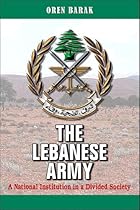‘The Lebanese Army’
May 22nd, 2009 by MESH
MESH invites selected authors to offer original first-person statements on their new books—why and how they wrote them, and what impact they hope and expect to achieve. Oren Barak is senior lecturer in political science and international relations at the Hebrew University of Jerusalem. His new book is The Lebanese Army: A National Institution in a Divided Society.
From Oren Barak
 The puzzle that my book grapples with might be familiar to those who have seen Monty Python and the Holy Grail, a movie that came out in 1975, the same year that Lebanon’s civil war broke out:
The puzzle that my book grapples with might be familiar to those who have seen Monty Python and the Holy Grail, a movie that came out in 1975, the same year that Lebanon’s civil war broke out:
Cart Master: Bring out yer dead.
[A customer puts a body on the cart]
Customer: Here’s one.
Cart Master: That’ll be ninepence.
Dead Person: I’m not dead.
Cart Master: What?
Customer: Nothing. There’s your ninepence.
Dead Person: I’m not dead.
Cart Master: ‘Ere, he says he’s not dead.
Customer: Yes he is.
Dead Person: I’m not.
Cart Master: He isn’t.
Customer: Well, he will be soon, he’s very ill.
Dead Person: I’m getting better.
Customer: No you’re not, you’ll be stone dead in a moment…
The “Dead Person” is Lebanon and the puzzle is how did this state, which so many observers had referred to as a “non-state state” (or a “failed state,” to use a more up-to-date term), manage to endure despite the long and devastating conflict (1975-90) and be resuscitated in its aftermath. The book suggests that the Lebanese Army has played a significant role in Lebanon’s survival.
Initially, I planned to write a more general account of Lebanon’s process of state formation, the causes for its “failure” in the 1970s and 1980s, and its reconstruction in the 1990s. But after some deliberation, I decided to focus on the Lebanese Army, which encapsulates these dramatic developments. After all, this was a military that was weak before the conflict, which had become paralyzed and nearly disintegrated along the lines of ethnicity, clan, and region in the initial stages of the war, but which managed to stay intact throughout this period and be successfully reconstructed in the postwar era. Indeed, today the Lebanese Army enjoys an unparalleled position in Lebanon, demonstrated not only by the widespread public support for its activities, such as the military operation that it launched against Fatah al-Islam, the radical Islamic faction in Tripoli, in 2007, but also in the election of the army commander, General Michel Suleiman, as Lebanon’s president in 2008.
It is important to note that this trajectory is markedly different from that of other military institutions in divided societies that witnessed intrastate conflict. In Yugoslavia, for example, the Yugoslav People’s Army disintegrated along with the state, and some of its men joined the various ethnic militias. Some of them, including high-ranking officers, soon perpetrated war crimes against their former compatriots. Although some Lebanese soldiers, too, joined various militias during the civil war, the bulk of the army’s personnel did not.
In order to solve the puzzle of the Lebanese Army’s endurance during the conflict, I decided to trace its origins from the creation of the first Lebanese military units by the French Army during the First World War until the attempts made by the Lebanese Army to restore Lebanon’s authority in the postwar era. Yet, when going through the vast resources that I gathered—the army’s bulletins, the Lebanese official gazette, memoirs and biographies of numerous Lebanese soldiers, Western archival material, the Lebanese and Arab press, and secondary works on Lebanon—I realized that any discussion of the history of the Lebanese Army (and of any military institution for that matter) must not limit itself to “objective” facts, but also relate to the ways that the army and its leaders—always conscious of the critical importance of history in the process of state formation—wished this past to be remembered.
Writing about a military institution in the Middle East, a region where security matters are still paramount, is no easy task. Yet, in the Lebanese case, I was struck by the wealth of resources on the army, most of which were previously untapped. Among others, this enabled me to collect biographical material on 4,453 officers who served in the Lebanese Army from its inception to the present in order to identify change and continuity in patterns of recruitment and military service. In this way, I was able to show that the Lebanese Army has gradually become more representative of the various sectors of Lebanese society—ethnic groups (or communities), large families (or clans), and regions—and this transformation preceded the political reforms that facilitated the ending of the conflict. Military institutions in divided societies, in other words, can be, and perhaps ought to be, representative institutions! I believe that this finding is relevant to other divided societies, including present-day Iraq.
In The Lebanese Army, I hope to achieve three main goals. The first is to call attention to the significant developments that have taken place in Lebanon in recent decades, and especially to the strengthening of the state’s institutions not only in the coercive sense but also in terms of their legitimacy. In my view, this process has considerable implications for Lebanon’s close neighbors, and especially for Israel, where many still treat Lebanon as a “non-state state.” A second goal is to encourage additional studies on military institutions—and on the realm of security generally—in divided societies, including most Middle Eastern countries. Finally, the book challenges scholars to rethink existing explanations for the “weakness” and “strength” of states in our times, as well as these concepts themselves. Lebanon, for one, is certainly not “dead” and there are many lessons to be learned from its experience.
 Posts+Comments
Posts+Comments Posts+Comments
Posts+Comments Posts+Comments
Posts+Comments Posts+Comments
Posts+Comments